The Chromebook Pixel (2015) Review
by Brandon Chester on March 16, 2015 8:00 AM EST- Posted in
- Laptops
- Chrome OS
- Chromebook
- Chromebook Pixel
Display
When the original Chromebook Pixel launched two years ago, its big selling point and the source of its name was its 239ppi 2560x1700 display. At that time, the only other laptops on the market with HiDPI displays were Apple's Retina MacBook Pros. Chromebooks have typically aimed for the low-cost segment of the laptop market, and so it was quite a surprise that one of the earliest HiDPI laptops was a Chromebook. Although the Pixel had the highest pixel density of any laptop display at the time, it fell somewhat short when it came to color reproduction due to its narrow color gamut and lack of calibration. With the new Chromebook Pixel, Google has advertised coverage of the sRGB color gamut, along with a maximum brightness of 400nits.
To see whether or not Google has hit their mark, we turn to our standard display testing workflow. As usual, all measurements are performed using SpectraCal's CalMAN 5 software along with X-Rite's i1Pro 2 spectrophotometer, with the exception of black level measurements which are performed with an i1Display Pro colorimeter.
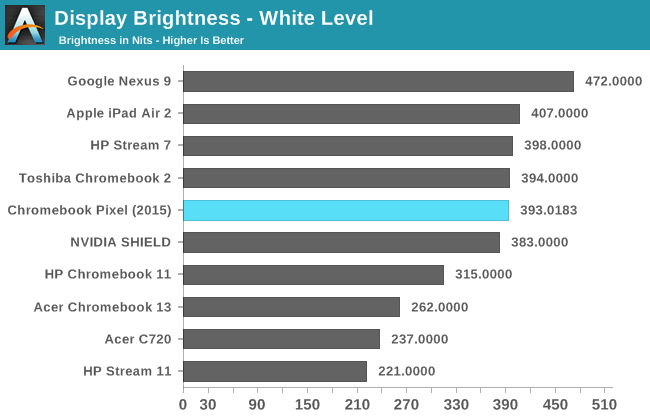
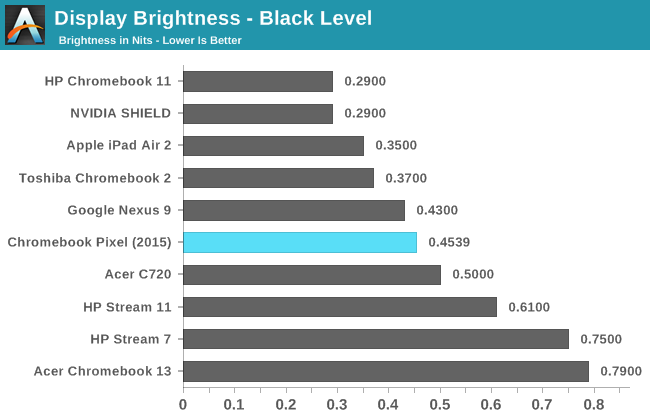
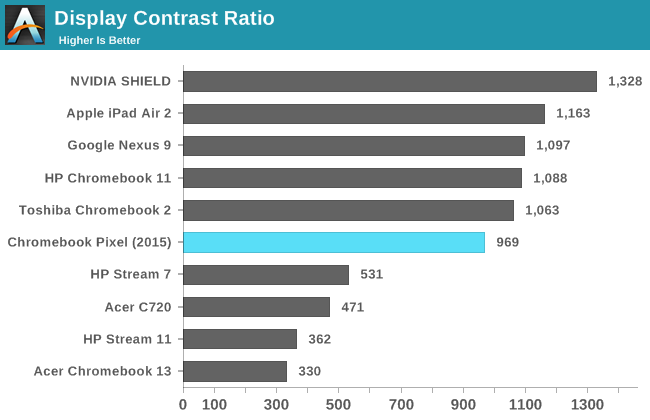
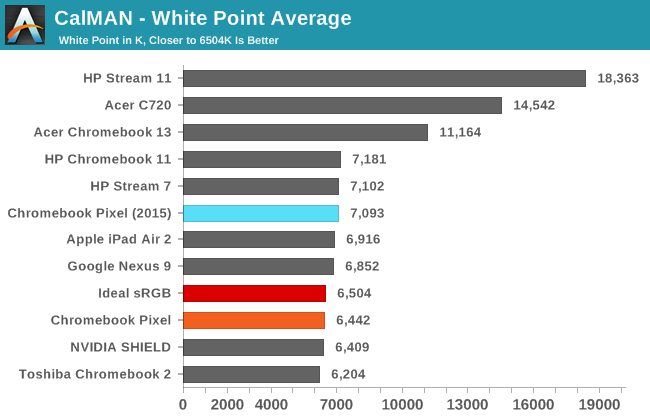
Due to the evolution of our display workflow as time has gone on, I don't have results to compare the new Pixel to the original for certain categories. The result for maximum brightness is certainly in line with Google's advertised 400nit brightness, while the black levels and contrast ratio are what you would expect of IPS panels. The white point is noticeably more blue than the ideal D6504 target, which contrasts with the original Pixel which was very slightly too red. The blue/green tint in white and shades of grey is also more obvious than most other devices with similar average white points, which I elaborate on further below.

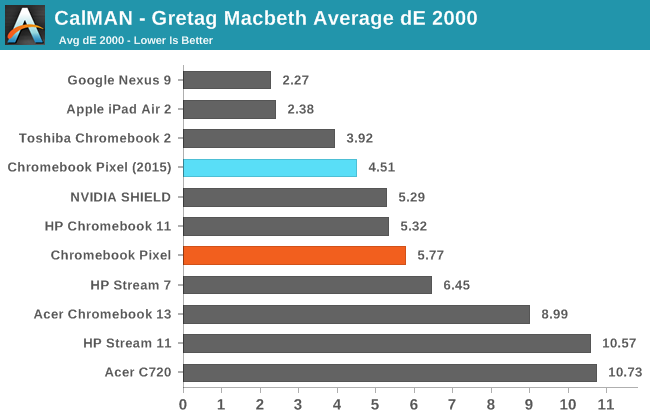
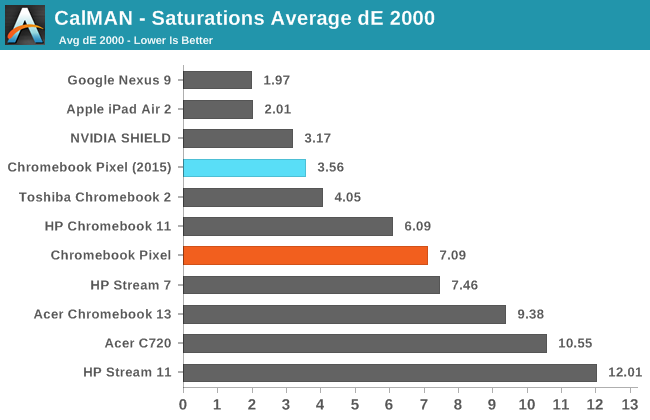
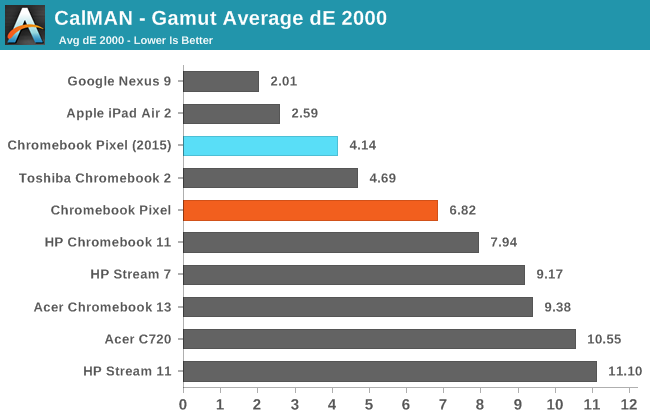
The new Pixel improves significantly upon the original in the gamut and saturation tests. It has a much wider gamut than the original, although it misses in magenta and yellow. Saturation improvements follow the improved gamut, as colors of 80% and 100% saturation no longer look identical. Despite these improvements, there hasn't been much progress on greyscale and color mixture accuracy. As noted earlier, the Pixel has a fairly obvious green/blue tint to the lighter shades of grey and white. As you can see in the gallery below, this is due to the reduction in red and increase in blue components of luminance as the shades of grey move from black to white.
I don't expect that many Chromebook users will be doing heavy photo and video editing that requires a perfectly calibrated display. Many $999 laptops ship with displays that are much worse than the one on the new Pixel, and I think that most users will be very happy with the Pixel's display. It's just a shame that Google doesn't seem to have put the same amount of care into display calibration with the Pixel as they have with the Nexus 9 and other Google branded devices, despite it having the highest price point of the devices they sell.
















123 Comments
View All Comments
some_guy - Saturday, April 11, 2015 - link
There are built in shortcuts for these keys along with a bunch of other shortcuts. ( Page up is Alt up arrow )https://support.google.com/chromebook/answer/18310...
My question is that if I were to install Linux, will the shortcuts also be there or will I have to do them myself somehow or search for something on the Internet. Thanks.
djscrew - Monday, March 16, 2015 - link
How come nearly every Chrome laptop is hideous.zodiacfml - Monday, March 16, 2015 - link
Too expensive. How much is the Yoga 3?cjb110 - Tuesday, March 17, 2015 - link
Is that battery charge test right? Seems a massive increase with no apparent reason that covers it, the components could only do so much. Kudos to Google if it is true, butl_d_allan - Tuesday, March 17, 2015 - link
Did I miss comments and evaluation about on-board storage? The SSD looks rather wimpy, but I didn't notice any numbers, charts, wordage one way or the other.Or is that considered irrelevant to a ChromeBook?
eanazag - Tuesday, March 17, 2015 - link
This is a laptop for Google employees.shm224 - Wednesday, March 18, 2015 - link
I still don't get why "browser/js engine" benchmarks are showing here as "CPU performance." I think Ho has once explained that that is purely for comparing the performance within the same product line, but I don't see any previous iterations (of Chromebooks) listed here. To the contrary, the web/js benchmarks are compared against the latest competing products as if they are at all relevant to CPU performance. I think the web/js benchmarks somewhat relevant here because everything on Chromebooks runs on Google's Chrome browser, but Anandtech still continues to use the same methodology to evaluate smartphones for instance where web browsing no longer represents much of smartphone usage.ntd11 - Friday, March 20, 2015 - link
How many here have tried a Chromebook for more than a few hours? I'm talking about logging in remotely and doing work from the comfort of a couch. Maybe its because I've been doing that sort of work since... 1992, back when the only computers that could do real work were called 'supercomputers' built up some habits. (Anyone else remember 'Xwindows?').After two years using a Chromebook I wanted something much better. For a year I haven't picked up my tablet. I either used my large smartphone, the Chromebook, or I wanted a multi-monitor workstation with the ergo keyboard/mouse, and enough RAM to actually do simulations.
I'm not the developer. But I look at it this way, everyone I've loaned my now obsolete Chromebook has bought one. Look at the benchmarks. If you log into a web page to work remotely, this is the machine. I used to have 20+ tabs open on a really low end Chromebook that would make a decent windows machine beg for mercy.
Take a minute to realize why the growing Chromebook community is excited about this laptop. I bet I'm the only one here actually posting from a Chromebook pixel. I came to read the review from a 'non-Chromebook fan site.'
Is it a great value? Well, so-so. But I wanted the long battery life. I like to wander to the back yard and work for hours. Then I wander into a quiet room and watch a movie. So nice to not worry about a power cord. The only downside is I find printing from a Chromebook not worth the hassle. I send documents to my windows machine and print from there. But look at the benchmarks. As a web browsing machine... this is fast.
Note: I do remote engineering. Not development for iPhones, Android, or Chromebooks. I use high end software that someone else has developed to simulate complex physics. This is now the Chromebook everyone can say 'that is too expensive' and buy one half (or less) the price. But
I find windows machines slow too much with age. My old Chromebook never did. Apple machines slow with every OS upgrade. It is preference.
HanTorso - Thursday, April 9, 2015 - link
I feel this would be great if it just had at least a 256gb ssd. I would install Linux on it, and maybe use the Chrome OS just for simple things. The most important element is the 3:2 aspect ratio, which makes it superior to any non-Apple laptop display. The price is still too expensive though, because except for the screen, it doesn''t seem to have any advantage over an Apple laptop of the same price.dodysw - Sunday, May 31, 2015 - link
Brandon, according to https://support.google.com/chromebook/answer/61645... the Chromebook Pixel 2015 battery capacity is 72Wh, not 59Wh as specified in your article.